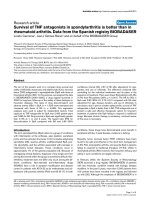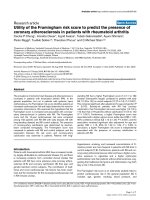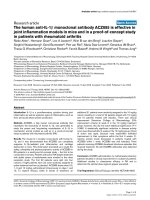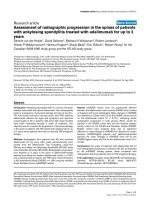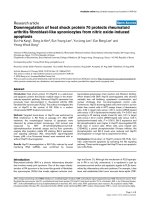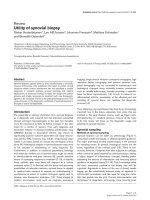Báo cáo y học: "Utility of the Framingham risk score to predict the presence of coronary atherosclerosis in patients with rheumatoid arthritis" pps
Bạn đang xem bản rút gọn của tài liệu. Xem và tải ngay bản đầy đủ của tài liệu tại đây (239.68 KB, 7 trang )
Open Access
Available online />Page 1 of 7
(page number not for citation purposes)
Vol 8 No 6
Research article
Utility of the Framingham risk score to predict the presence of
coronary atherosclerosis in patients with rheumatoid arthritis
Cecilia P Chung
1
, Annette Oeser
1
, Ingrid Avalos
1
, Tebeb Gebretsadik
2
, Ayumi Shintani
2
,
Paolo Raggi
3
, Tuulikki Sokka
1,4
, Theodore Pincus
1
and C Michael Stein
1,5
1
Department of Medicine, Vanderbilt University School of Medicine, 1161 21st Ave., Nashville, TN 37232, USA
2
Department of Biostatistics, Vanderbilt University School of Medicine, S-2323 Medical Center North, Nashville, TN 37232, USA
3
Department of Medicine, Division of Cardiology, Emory University School of Medicine, 1365 Clifton Road NE, AT-504, Atlanta, GA 30322
4
Jyväskylä Central Hospital, 40620 Jyväskylä, Finland
5
Department of Pharmacology, Vanderbilt University School of Medicine, 542 RRB, Nashville, TN 37232, USA
Corresponding author: C Michael Stein,
Received: 24 Jul 2006 Revisions requested: 23 Aug 2006 Revisions received: 25 Oct 2006 Accepted: 14 Dec 2006 Published: 14 Dec 2006
Arthritis Research & Therapy 2006, 8:R186 (doi:10.1186/ar2098)
This article is online at: />© 2006 Chung et al.; licensee BioMed Central Ltd.
This is an open access article distributed under the terms of the Creative Commons Attribution License ( />),
which permits unrestricted use, distribution, and reproduction in any medium, provided the original work is properly cited.
Abstract
The prevalence of ischemic heart disease and atherosclerosis is
increased in patients with rheumatoid arthritis (RA). In the
general population, but not in patients with systemic lupus
erythematosus, the Framingham risk score identifies patients at
increased cardiovascular risk and helps determine the need for
preventive interventions. We examined the hypothesis that the
Framingham score is increased and associated with coronary-
artery atherosclerosis in patients with RA. The Framingham
score and the 10-year cardiovascular risk were compared
among 155 patients with RA (89 with early disease, 66 with
long-standing disease) and 85 control subjects. The presence
of coronary-artery calcification was determined by electron-
beam computed tomography. The Framingham score was
compared in patients with RA and control subjects, and the
association between the risk score and coronary-artery
calcification was examined in patients. Patients with long-
standing RA had a higher Framingham score (14 [11 to 18])
(median [interquartile range]) compared to patients with early
RA (11 [8 to 14]) or control subjects (12 [7 to 14], P < 0.001).
This remained significant after adjustment for age and gender (P
= 0.015). Seventy-six patients with RA had coronary
calcification; their Framingham risk score was higher (14 [12 to
17]) than that of 79 patients without calcification (10 [5 to 14])
(P < 0.001). Furthermore, a higher Framingham score was
associated with a higher calcium score (odds ratio [OR] = 1.20,
95% confidence interval [CI] 1.12 to 1.29, P < 0.001), and the
association remained significant after adjustment for age and
gender (OR = 1.15, 95% CI 1.02 to 1.29, P = 0.03). In
conclusion, a higher Framingham risk score is independently
associated with the presence of coronary calcification in
patients with RA.
Introduction
Patients with rheumatoid arthritis (RA) have increased mortal-
ity, largely attributable to cardiovascular disease [1], and there
is increasing evidence from controlled clinical studies that
patients with RA have more extensive extra-coronary athero-
sclerosis [2-5] and coronary calcification [6] than age- and
gender-matched control subjects. The contribution of tradi-
tional and novel cardiovascular risk factors has been exam-
ined, but the mechanism for this increased cardiovascular risk
in RA remains unclear.
Hypertension, smoking, and increased concentrations of C-
reactive protein are more frequent in patients with RA than in
control subjects [7,8]. Furthermore, patients with RA and cor-
onary-artery atherosclerosis are older and have a higher cumu-
lative exposure to cigarettes and a higher erythrocyte
sedimentation rate than patients without atherosclerosis, sug-
gesting that traditional risk factors and inflammation may both
play a role in the process [6].
The Framingham risk score is an extensively studied index to
predict cardiovascular risk in the general population [9]. It
includes age, gender, smoking, blood pressure, and
CI = confidence interval; DAS28 = disease activity score using 28 joint counts; HDL = high-density lipoprotein; HU = Hounsfield units; LDL = low-
density lipoprotein; OR = odds ratio; RA = rheumatoid arthritis; SLE = systemic lupus erythematosus.
Arthritis Research & Therapy Vol 8 No 6 Chung et al.
Page 2 of 7
(page number not for citation purposes)
cholesterol concentrations and estimates the risk of coronary
events by stratifying individuals into three risk categories: low
(<10% risk of an event in 10 years), intermediate (10% to
20%), and high (>20%) [10]. Although the Framingham risk
score is widely used in the general population to determine
prognosis and the need for intervention [9], the value of this
risk score is less clear in younger patients, women, and
patients with inflammatory diseases [11,12]. For example, in
patients with systemic lupus erythematosus (SLE), another
rheumatic disease associated with increased coronary calcifi-
cation, there were no differences in the Framingham risk score
in patients and controls, and the majority of the SLE patients
with coronary calcification had a low 10-year risk according to
the Framingham calculations [12].
In contrast to the general population, there is no information
about the relationship between the Framingham cardiovascu-
lar risk score and coronary calcification in patients with RA.
Therefore, we tested the hypothesis that the Framingham car-
diovascular risk score would be associated with coronary cal-
cification in patients with RA.
Materials and methods
Eighty-nine patients with early RA who had a median (inter-
quartile range) disease duration of 2 (1 to 3) years and mean
age of 51 ± 11 (mean ± standard deviation) years, 66 patients
with long-standing RA (median disease duration 19 [14 to 24]
years), aged 57 ± 10 years, who met the classification criteria
for RA [13], and 85 control subjects aged 52 ± 10 years were
studied. Control subjects did not meet the classification crite-
ria for RA or any other autoimmune disease and were fre-
quency-matched for age, gender, and race with patients with
RA (early and long-standing disease combined). These
patients and control subjects are part of an ongoing cohort
study to identify cardiovascular risk factors in RA [6]. The
study was approved by the Institutional Review Board of Van-
derbilt University Hospital, and all subjects gave written
informed consent.
Clinical assessment
Patients and control subjects were assessed according to a
standardized clinical interview, physical examination, labora-
tory tests, and (in patients) chart review. Family history of cor-
onary disease was defined as a first-degree relative who had
had a myocardial infarction or stroke before the age of 55 in
males or 65 in females. Height and weight were measured,
and body mass index was calculated by dividing the weight in
kilograms by the square of the height in meters. Blood pres-
sure was recorded as the mean of two measurements
obtained 5 minutes apart after subjects had rested in a supine
position for 10 minutes.
Laboratory tests
After an overnight fast, blood was collected for measurement
of glucose, total cholesterol, high-density lipoprotein (HDL),
triglycerides, Lp(a) lipoprotein, and homocysteine concentra-
tions and the calculation of low-density lipoprotein (LDL).
RA measurements of disease activity and other
outcomes
In patients with RA, disease activity was measured with the
use of the disease activity score using 28 joint counts
(DAS28) [14]. All patients and control subjects completed a
Modified Health Assessment Questionnaire that provided
scores for physical function, pain (0 to 10 cm, visual analog
scale), and fatigue (visual analog scale) [15].
Framingham score
The composite simplified coronary prediction model built on
the blood pressure and cholesterol categories proposed by
the Joint National Committee on Blood Pressure and the
National Cholesterol Education Program was used. This
model includes age, total and HDL cholesterol, blood pres-
sure, and smoking and was designed in the setting of a com-
munity-based cohort (Framingham) of more than 5,000 people
followed for 12 years [9].
Coronary-artery calcification
All subjects underwent imaging with an Imatron C-150 scan-
ner (GE Imatron, now part of GE Healthcare, Little Chalfont,
Buckinghamshire, UK) as described previously [6]. Briefly,
imaging was performed with a 100-millisecond scanning time
and a single-slice thickness of 3 mm. Forty slices were
obtained during a single breath-holding period starting at the
aortic arch and proceeding to the level of the diaphragm. Tom-
ographic imaging was electrocardiographically triggered at
60% of the interval between R waves. All areas of calcification
within the borders of a coronary artery with a minimal attenua-
tion of 130 Hounsfield units (HU) were computed. A calcified
coronary plaque was considered present if at least three con-
tiguous pixels were detected (voxel size, 1.03 mm
3
). All the
scans were read by a single expert investigator (PR), unaware
of the subjects' clinical status.
Calculation of calcium scores
The degree of coronary-artery calcification was calculated as
described by Agatston et al. [16]. The area of each calcified
plaque is multiplied by the peak radiological attenuation inside
this area expressed as a coefficient (1 = for an attenuation of
130 to 199 HU; 2 = 200 to 299 HU; 3 = 300 to 400 HU; and
4 = more than 400 HU). The sum of the scores for all coronary
arterial lesions provides an overall score for each individual.
Statistical analysis
Clinical characteristics and the cardiovascular risk scores
were compared in patients with early RA, patients with long-
standing RA, and control subjects using Kruskal-Wallis or Wil-
coxon rank sum tests for continuous variables and Fisher's
exact test for categorical variables. The correlation between
Framingham score and continuous clinical characteristics was
Available online />Page 3 of 7
(page number not for citation purposes)
performed using the Spearman correlation coefficient (ρ). A
multiple linear regression model with adjustment for age and
gender was used to assess the difference in the Framingham
score among control subjects and patients with early and
long-standing RA.
Coronary calcium scores were classified as absent (0), mini-
mal to mild (1 to 100), moderate (101 to 400), and severe
(>400), and the association between these categories and the
risk score was examined by proportional logistic regression in
patients with RA and control subjects. In the multivariable anal-
yses, non-linear effect of age was evaluated using a restricted
cubic spline [17]. All analyses used a 5% two-sided signifi-
cance level and were performed with STATA 9.1 and R 2.1.0
(STATACorp, College Station, TX, USA) [18].
Results
Demographic characteristics and cardiovascular risk factors
of patients with RA and control subjects are shown in Table 1.
Patients with RA had a median DAS28 of 3.29 (2.26 to 4.29),
median C-reactive protein of 4 (3 to 11) mg/l, and median
erythrocyte sedimentation rate of 15 (7 to 35) mm/hour. One
hundred eleven (72%) were current users of methotrexate. As
reported previously [6], several traditional cardiovascular risk
factors differed among the three groups, including individual
components of the Framingham equation such as age (P =
0.002), percentage of current smokers (P = 0.004), and systo-
lic blood pressure (P = 0.001). Serum concentrations of total
and HDL cholesterol were not statistically significant (P =
0.22 and P = 0.16, respectively). Patients with long-standing
disease had higher Framingham risk scores (14 [11 to 18]
units) than patients with early disease (11 [8 to 14] units) or
control subjects (12 [7 to 14] units) (P < 0.001). The associ-
ation for long-standing RA versus control subjects remained
significant after statistical adjustment for age and gender (β =
1.38 [95% confidence interval (CI) 0.26 to 2.49], P = 0.015).
These results remained significant after further adjustment for
homocysteine (β = 1.36 [95% CI 0.24 to 2.49], P = 0.018).
Framingham scores were significantly higher (14 [12 to 17]
units) in 76 patients with RA who had coronary-artery calcifi-
cation compared with 79 patients who did not have coronary
calcification (10 [5 to 14] units) (P < 0.001). Figure 1 shows
the Framingham risk score and the 10-year risk according to
coronary calcification categories. The Framingham risk scores
were correlated with Agatston scores (ρ = 0.44, P < 0.001),
and an increase in one unit of the Framingham risk score was
associated with a 20% increase in the odds of higher Agat-
ston scores (odds ratio [OR] = 1.20, 95% CI 1.12 to 1.29, P
< 0.001). This association remained significant after adjust-
Table 1
Clinical characteristics of patients with rheumatoid arthritis and control subjects.
Characteristic Patients with early rheumatoid
arthritis (n = 89)
Patients with long-standing
rheumatoid arthritis (n = 66)
Control subjects (n = 85) P value
a
Demographic variables
Age in years 51 (43–59) 57 (48–65) 52 (44–58) 0.002
Female gender, n (percentage) 57 (64%) 49 (74%) 55 (65%) 0.35
Caucasian, n (percentage) 81 (91%) 57 (86%) 72 (84%) 0.51
Components of the Framingham risk score
b
Total cholesterol (mg/dl) 182 (156–210) 188 (149–211) 195 (171–216) 0.22
Smoking, n (percentage) 19 (21.4%) 20 (30.3%) 8 (9.4%) 0.004
High-density lipoprotein (mg/dl) 41 (37–53) 46 (40–56) 45 (39–54) 0.16
Systolic blood pressure (mm Hg) 128 (116–139) 138 (124–150) 128 (115–136) 0.001
Framingham risk score (units) 11 (8–14) 14 (11–18) 12 (7–14) <0.001
Ten-year risk of a cardiovascular event 2% (1%–6%) 6% (2%–11%) 2% (1%–8%) 0.006
Other cardiovascular risk factors
Family history of coronary heart disease, n (percentage) 23 (26%) 19 (29%) 26 (31%) 0.78
Body mass index (kg/m
2
) 28 (25–34) 28 (24–31) 27 (25–32) 0.51
Low-density lipoprotein (mg/dl) 111 (93–135) 114 (83–135) 122 (104–145) 0.07
Lp(a) lipoprotein (mg/dl) 8.1 (2.0–24.6) 8.7 (4.0–23.2) 9.9 (4.0–32.3) 0.24
Triglycerides (mg/dl) 108 (78–141) 111 (81–172) 103 (74–135) 0.43
Homocysteine (μmol/l) 9.5 (8.1–11.4) 10.7 (8.1–12.3) 8.2 (7.1–9.6) <0.001
a
P values were calculated using Fisher's exact test for categorical variables and Wilcoxon rank sum test for continuous variables;
b
Other than age and gender. Continuous values are presented as median (interquartile range).
Arthritis Research & Therapy Vol 8 No 6 Chung et al.
Page 4 of 7
(page number not for citation purposes)
ment for age and gender (OR = 1.15, 95% CI 1.02 to 1.29, P
= 0.03) and after further adjustment for homocysteine concen-
trations (OR = 1.15, 95% CI 1.01 to 1.30, P = 0.03). Similar
results were found in control subjects, in whom the associa-
tion between the Framingham score and coronary calcium
score was significant (OR = 1.18, 95% CI 1.07 to 1.31, P <
0.001), and remained independent of age, gender, systolic
blood pressure, and homocysteine (OR = 1.20, 95% CI 1.02
to 1.41, P = 0.03). However, the association of the Framing-
ham risk score and coronary calcification is not modified by
disease status (interaction analysis, P = 0.48), suggesting that
the Framingham risk score has similar predictive ability among
patients with RA and control subjects.
Patients with coronary calcification also had a higher pre-
dicted 10-year Framingham risk of a cardiovascular event (7%
[4% to 12%]) than patients who did not have calcification (1%
[<1% to 4%]) (P < 0.001). Table 2 shows the correlations
between the Framingham risk score and clinical characteris-
tics and cardiovascular risk factors among patients with RA.
As expected, the score was significantly correlated with its
individual components: age (ρ = 0.76, P < 0.001), systolic
blood pressure (ρ = 0.60, P < 0.001), and total cholesterol (ρ
= 0.27, P < 0.001). In addition, other cardiovascular risk fac-
tors such as concentrations of triglycerides (ρ = 0.26, P =
0.001), diastolic blood pressure (ρ = 0.22, P = 0.006), and
LDL cholesterol (ρ = 0.22, P = 0.005) were also significantly
correlated with the Framingham score. Some specific disease
characteristics, including disease duration (ρ = 0.29, P <
0.001) and cumulative corticosteroids (ρ = 0.17, P = 0.03),
were correlated significantly with the Framingham score, but
cumulative hydroxychloroquine (P = 0.53) and functional
capacity (P = 0.90) were not. An association with DAS28 was
of borderline significance (P = 0.07).
Figure 2 depicts the results of a multivariable model examining
Figure 1
Framingham risk score, the calculated 10-year risk of a cardiovascular event, and coronary-artery calcification of varying severity in patients with rheumatoid arthritis (RA) and control subjectsFramingham risk score, the calculated 10-year risk of a cardiovascular event, and coronary-artery calcification of varying severity in patients with
rheumatoid arthritis (RA) and control subjects. Framingham score (a) and the calculated 10-year risk of a cardiovascular event (b) and coronary-
artery calcification of varying severity in patients with RA and control subjects. Error bars represent mean and 95% confidence interval.
Available online />Page 5 of 7
(page number not for citation purposes)
the association of the Framingham risk and coronary calcium
scores after adjusting for disease status, age, gender, and
homocysteine. Differences in the intercept indicate that
patients with long-standing RA (late) have a greater probability
of having higher coronary calcium scores than control sub-
jects, independent of Framingham risk scores (OR = 2.46,
95% CI 1.20 to 5.05).
The control group was frequency-matched for age and gender
with the entire group of RA patients and thus predictably did
not exactly match with either the early or late RA groups. Minor
differences between the groups were dealt with by the use of
multivariable adjusted analyses. To further confirm our results,
we performed sensitivity analyses between all patients with
long-standing RA (mean age 56.7 ± 10.5 years, 25.8% male)
and 66 matched control subjects (mean age 55.0 ± 7.6 years,
25.8% male). The association between RA and Framingham
score was of borderline significance (β = 1.62, 95% CI -0.01
to 3.26, P = 0.05) and remained significant after adjusting for
age, gender, and homocysteine (β = 1.40, 95% CI 0.17 to
2.64, P = 0.03). Also, the association between the Framing-
ham risk and coronary calcium scores was significant (unad-
justed OR = 1.16, 95% CI 1.07 to 1.25, P < 0.001) and
remained so after adjustment for age, gender, and homo-
cysteine (OR = 1.21, 95% CI 1.08 to 1.35, P = 0.001).
Discussion
The two primary findings in this report are that patients with
long-standing RA had higher Framingham risk scores com-
pared with patients with early disease and control subjects
and that patients with coronary calcification also have higher
Framingham scores than those without coronary calcification.
The Framingham risk score includes age, gender, total and
HDL cholesterol, blood pressure, diabetes, and smoking to
derive an estimated risk of developing coronary heart disease
within 10 years [9]. However, despite widespread use, the
guidelines underestimate the presence of coronary calcifica-
tion in certain populations, particularly women [11]. Because
RA affects predominantly women, the utility of the Framingham
risk score in this patient population is of interest, particularly
considering that in patients with SLE, the Framingham risk
score does not differ among patients and control subjects, and
is inadequate for cardiovascular risk stratification [12,19].
Smoking and hypertension, two of the components of the
Framingham risk score, differed among patients with early RA,
patients with long-standing RA, and control subjects. There
were more smokers among patients with early and late RA
than among control subjects, and patients with late disease
had higher systolic blood pressure. These differences explain
in part why patients with long-standing disease had higher risk
Table 2
Spearman correlations between the Framingham risk score
and clinical variables in patients with rheumatoid arthritis
ρ P value
Age (years) 0.76 <0.001
Systolic blood pressure (mm Hg) 0.60 <0.001
Diastolic blood pressure (mm Hg) 0.22 0.006
Body mass index (kg/m
2
) -0.03 0.68
Disease duration (years) 0.29 <0.001
Pack-years of smoking 0.11 0.16
Coronary calcium score (Agatston units) 0.44 <0.001
Total cholesterol (mg/dl) 0.27 <0.001
HDL cholesterol (mg/dl) -0.02 0.83
LDL cholesterol (mg/dl) 0.22 0.005
Triglycerides (mg/dl) 0.26 0.001
Lp(a) lipoprotein (mg/dl) 0.09 0.26
Cumulative use of steroids (grams) 0.17 0.03
Cumulative use of hydroxychloroquine (grams) -0.05 0.53
Modified Health Assessment Questionnaire (0–3) 0.01 0.90
Disease activity score (DAS28) 0.15 0.07
Higher scores in the Modified Health Assessment Questionnaire
indicate more difficulty in performing activities of daily living. Higher
scores for the disease activity score using 28 joint counts (DAS28)
indicate greater disease activity. HDL, high-density lipoprotein; LDL,
low-density lipoprotein.
Figure 2
Relationship between the Framingham risk score and the probability of higher calcium scores among patients with early and long-standing rheumatoid arthritis (RA) and control subjectsRelationship between the Framingham risk score and the probability of
higher calcium scores among patients with early and long-standing
rheumatoid arthritis (RA) and control subjects. The results of a multivar-
iable model examining the association of the Framingham risk and coro-
nary calcium scores after adjusting for disease status, age, gender, and
homocysteine are depicted. Due to differences in the intercept,
patients with long-standing RA (late) have a greater probability of
higher coronary calcium scores than control subjects, independent of
Framingham risk scores (odds ratio = 2.46, 95% confidence interval
1.20 to 5.05).
Arthritis Research & Therapy Vol 8 No 6 Chung et al.
Page 6 of 7
(page number not for citation purposes)
scores after adjustment for age and gender. This finding
appears to be important as both risk factors can be modified,
thus emphasizing the need for behavioral and therapeutic
interventions and better control of common comorbidities in
patients with RA.
The association between the Framingham risk score and addi-
tional cardiovascular risk factors and RA-specific characteris-
tics such as cumulative exposure to corticosteroids and
disease duration is of interest, as is the association between
the Framingham risk score and the severity of coronary calcifi-
cation in patients with RA. However, although the Framingham
score and the 10-year risk estimates were higher in patients
with coronary calcification, the majority of patients with coro-
nary calcification were classified as being at 'low' 10-year risk
and only 29 of 76 patients (38%) were at moderate or high risk
according to the Framingham risk score. To improve predic-
tion of future cardiovascular events in the general population,
novel risk factors such as coronary calcium score have been
studied.
A meta-analysis including asymptomatic individuals indicated
that those with coronary-artery calcification above the median
have an 8.7-fold increased risk of future coronary events [20].
In addition, there are data indicating that progression in cal-
cium scores is associated with higher risk of myocardial infarc-
tion [21], and coronary-artery calcification adds information to
the prediction of overall mortality [22]. Thus, efforts have been
made to improve the prediction of risk by combining the Fram-
ingham risk score with coronary calcium score, and this com-
bination appears of value to estimate risk in the general
population [23,24]. In RA patients with coronary calcification,
the use of such a modified Framingham score would increase
the estimation of 10-year risk from a mean of 7% (4% to 12%)
to 12% (5% to 22%) and 51 of 76 patients with coronary cal-
cification would be classified as being at moderate to high risk
and therefore would be candidates for aggressive therapeutic
interventions.
Conclusion
Patients with RA and coronary-artery atherosclerosis have
higher Framingham cardiovascular risk scores even after
adjustment for age and gender. However, current risk stratifi-
cation classified most patients with RA as having a low 10-
year risk of hard events. The use of coronary-artery calcium
scores may add information to the assessment of cardiovascu-
lar risk in patients with RA and may lead to better guidelines
for therapeutic interventions in this patient population. Further
prospective studies are needed to examine the utility of the
Framingham and the modified Framingham scores to predict
hard events in patients with RA.
Competing interests
CPC received a CHORD (Centocor Health Outcomes in
Rheumatic Diseases) Fellowship in 2004 and support from
the following grants: HL065082, HL067964, HS010384, and
HHSA290200500421. IA received an American College of
Rheumatology Research and Education Foundation 2006
Fellowship award. In PR's opinion, this is not relevant to the
article, but in the interests of full disclosure, an honoraria is
declared (Genzyme Corporation, Cambridge, MA, USA). TS
received support from grant HL067964 and honoraria (several
from different companies and foundations). CMS received
support from the following grants: RO1 HL65082, HL04012,
HL67964, U01 HL65962, P01 GM31304, U18 HS010384,
RO1 HL081707, and a Lupus Foundation grant. In CMS's
opinion, these are not relevant to the article, but in the interests
of full disclosure, the following are declared:consultant fees
from Bristol-Myers Squibb Company (Princeton, NJ, USA) for
preparation of a series of lectures on trial design; royalty fees
from the publication of textbooks of rheumatology; fees from
medicolegal chart review in two cases of drug toxicity; an hon-
orarium from the American Society of Clinical Pharmacology
and Therapeutics for editing their journal; and fees from the
National Institutes of Health for participating in peer review.
CMS holds a patent on the use of interleukin-2 to monitor
cyclosporine activity; the patent has yielded no income. All
other authors declare that they have no competing interests.
Authors' contributions
CPC performed data entry and analysis, assisted in study
design, and wrote the first draft. AO collected and entered
data and assisted with study design and manuscript writing. IA
assisted with data entry, analysis, and manuscript writing. TG
and AS performed statistical analysis and assisted in manu-
script writing. PR analyzed the electron-beam computed tom-
ography scans and assisted with study design and manuscript
writing. TS and TP recruited patients and assisted with study
design and manuscript writing. CMS provided the design and
overall supervision of the study and performed data analysis
and manuscript writing. All authors read and approved the final
manuscript.
Acknowledgements
We thank Carol Brannon and Elizabeth Simpson for helping with the
recruitment of patients.
This study was supported by grants (HL04012, HL67964, and
GM5M01-RR00095) from the National Institutes of Health and by the
Arthritis Foundation. IA is partially supported by a grant from the Ameri-
can College of Rheumatology.
References
1. Pincus T, Callahan LF: Taking mortality in rheumatoid arthritis
seriously–predictive markers, socioeconomic status and
comorbidity. J Rheumatol 1986, 13:841-845.
2. Park YB, Ahn CW, Choi HK, Lee SH, In BH, Lee HC, Nam CM, Lee
SK: Atherosclerosis in rheumatoid arthritis: morphologic evi-
dence obtained by carotid ultrasound. Arthritis Rheum 2002,
46:1714-1719.
3. Kumeda Y, Inaba M, Goto H, Nagata M, Henmi Y, Furumitsu Y,
Ishimura E, Inui K, Yutani Y, Miki T, et al.: Increased thickness of
the arterial intima-media detected by ultrasonography in
Available online />Page 7 of 7
(page number not for citation purposes)
patients with rheumatoid arthritis. Arthritis Rheum 2002,
46:1489-1497.
4. Gonzalez-Juanatey C, Llorca J, Testa A, Revuelta J, Garcia-Porrua
C, Gonzales-Gay MA: Increased prevalence of severe subclini-
cal atherosclerotic findings in long-term treated rheumatoid
arthritis patients without clinically evident atherosclerotic
disease. Medicine 2003, 82:407-413.
5. Roman MJ, Moeller E, Davis A, Paget SA, Crow MK, Lockshin MD,
Sammaritano L, Devereux RB, Schwartz JE, Levine DM, Salmon JE:
Preclinical carotid atherosclerosis in patients with rheumatoid
arthritis. Ann Intern Med 2006, 144:249-256.
6. Chung CP, Oeser A, Raggi P, Gebretsadik T, Shintani AK, Sokka
T, Pincus T, Avalos I, Stein CM: Increased coronary-artery
atherosclerosis in rheumatoid arthritis: relationship to disease
duration and cardiovascular risk factors. Arthritis Rheum 2005,
52:3045-3053.
7. Solomon DH, Curhan GC, Rimm EB, Cannuscio CC, Karlson EW:
Cardiovascular risk factors in women with and without rheu-
matoid arthritis. Arthritis Rheum 2004, 50:3444-3449.
8. Dessein PH, Joffe BI, Stanwix AE: Inflammation, insulin resist-
ance, and aberrant lipid metabolism as cardiovascular risk fac-
tors in rheumatoid arthritis. J Rheumatol 2003, 30:1403-1405.
9. Wilson PW, D'Agostino RB, Levy D, Belanger AM, Silbershatz H,
Kannel WB: Prediction of coronary heart disease using risk
factor categories. Circulation 1998, 97:1837-1847.
10. Ford ES, Giles WH, Mokdad AH: The distribution of 10-year risk
for coronary heart disease among US adults: findings from the
National Health and Nutrition Examination Survey III. J Am
Coll Cardiol 2004, 43:1791-1796.
11. Mahoney LT, Burns TL, Stanford W, Thompson BH, Witt JD, Rost
CA, Lauer RM: Usefulness of the Framingham risk score and
body mass index to predict early coronary artery calcium in
young adults (Muscatine Study). Am J Cardiol 2001,
88:509-515.
12. Chung CP, Oeser A, Avalos I, Raggi P, Stein CM: Cardiovascular
risk scores underestimate the presence of subclinical coro-
nary-artery atherosclerosis in women with systemic lupus
erythematosus. Lupus 2006, 15:562-569.
13. Arnett FC, Edworthy SM, Bloch DA, McShane DJ, Fries JF, Cooper
NS, Healey LA, Kaplan SR, Liang MH, Luthra HS, et al.: The Amer-
ican Rheumatism Association 1987 revised criteria for the
classification of rheumatoid arthritis. Arthritis Rheum 1988,
31:315-324.
14. Prevoo ML, van't Hof MA, Kuper HH, van Leeuwen MA, van de
Putte LB, van Riel PL: Modified disease activity scores that
include twenty-eight-joint counts. Development and validation
in a prospective longitudinal study of patients with rheumatoid
arthritis. Arthritis Rheum 1995, 38:44-48.
15. Pincus T, Sokka T, Kautiainen H: Further development of a phys-
ical function scale on a MDHAQ [corrected] for standard care
of patients with rheumatic diseases. J Rheumatol 2005,
32:1432-1439.
16. Agatston AS, Janowitz WR, Hildner FJ, Zusmer NR, Vaimonte M Jr,
Detrano R: Quantification of coronary artery calcium using
ultrafast computed tomography. J Am Coll Cardiol 1990,
15:827-832.
17. Harrell F: Regression Modeling Strategies New York: Springer;
2001.
18. The R Project for Statistical Computing [http://www.r-
project.org/]
19. Esdaile JM, Abrahamowicz M, Grodzicky T, Li Y, Panaritis C, du
Berger R, Cote R, Grover SA, Fortin PR, Clarke AE, Senecal JL:
Traditional Framingham risk factors fail to fully account for
accelerated atherosclerosis in systemic lupus erythematosus.
Arthritis Rheum 2001, 44:2331-2337.
20. O'Malley PG, Taylor AJ, Jackson JL, Doherty TM, Detrano RC:
Prognostic value of coronary electron-beam computed tom-
ography for coronary heart disease events in asymptomatic
populations. Am J Cardiol 2000, 85:945-948.
21. Raggi P, Cooil B, Shaw LJ, Aboulhson J, Takasu J, Budoff M, Cal-
lister TQ: Progression of coronary calcium on serial electron
beam tomographic scanning is greater in patients with future
myocardial infarction. Am J Cardiol 2003, 92:827-829.
22. Shaw LJ, Raggi P, Schisterman E, Berman DS, Callister TQ: Prog-
nostic value of cardiac risk factors and coronary artery calcium
screening for all-cause mortality. Radiology 2003,
228:826-833.
23. Becker CR, Majeed A, Crispin A, Knez A, Schoepf UJ, Boekste-
gers P, Steinbeck G, Reiser MF: CT measurement of coronary
calcium mass: impact on global cardiac risk assessment. Eur
Radiol 2005, 15:96-101.
24. Schisterman EF, Whitcomb BW: Coronary age as a risk factor in
the modified Framingham risk score. BMC Med Imaging 2004,
4:1.



